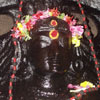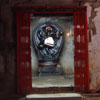Shiva's Dance in Stone:
Ananda Tandava, Bhujangalalita, Bhujangatrasa
Fig. 8: Shiva Nataraja in the Suttha Rathnagirishvarar, Oothathoor
Stone, probably granite
Oothathoor, Tamil Nadu, India
date unknown 160 centimeter without the pedestal
190 centimeter including the pedestal (approximately)
14 February 2012, by Liesbeth Pankaja Bennink, Kandhan Raja Deekshithar, Jayakumar Raja Deekshithar, Shankar Raja Deekshithar
The sanctum of this stone Nataraja is situated in the North-East corner of the prakara, faces south and is open and spacious. Only the Nataraja and the Sivakamasundari are present. Only two steps lead into this space where the pedestal of the Nataraja and his consort are placed on what can be called a very low platform.
With the pedestal this murti is possibly some 2 meter high. Without the pedestal this Nataraja is approximately 1.60 meter tall. The lowest part of the pedestal is square with a part left standing in the right corner. Above this the pedestal is round or oval in shape and consists of levels of molding.
Its prabha is oval with two rather slender unpronounced makaras placed at its base. Its main body is broad and round and is encompassed by two slender rims. The flames are almost abstract and look almost like small waves. They are positioned close together. Where the headdress touches and covers the prabha, some kind of wave-shaped decoration is forming the top of the prabha. Around the makaras that form the base of the prabha are curling or waving decorations possibly foliage.
The Apasmara lies with its head to the proper right. It wears a diadem or a row of curls around its face and holds a relatively small cobra in its hand.
There are only a few (3 or 4) jata or dread-locks which partly fall down, partly curl up around two hollowed out parts of the background of the murti. Otherwise this murti is solid stone. The goddess Ganga is positioned on the proper right side on the highest jata. The head is topped with a double fan of feathers or leaves with a skull in the center. Other hair attributes cannot be verified because of the flowers offered on the head.
The female and male earrings are clearly defined.
The upper-right hand holds the damaru. On the upper left a small vessel forms the base for the flame. Between the dola-hasta and the raised leg is something which may be another cobra.



